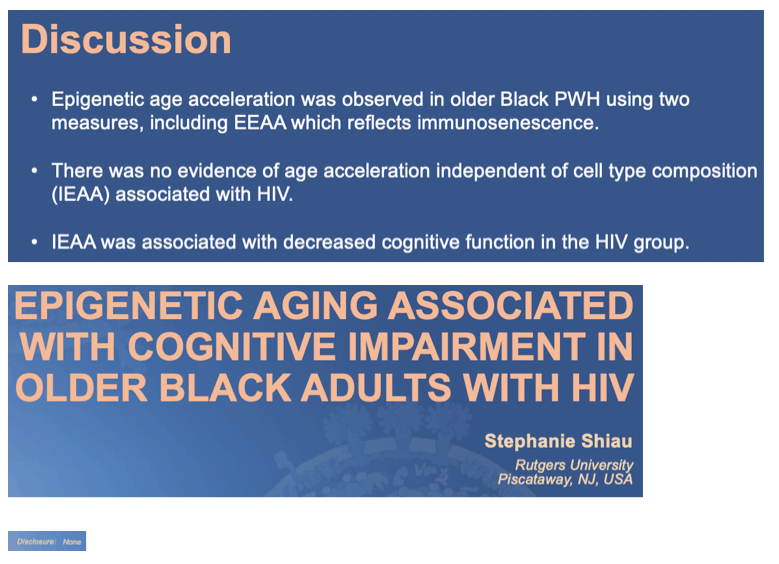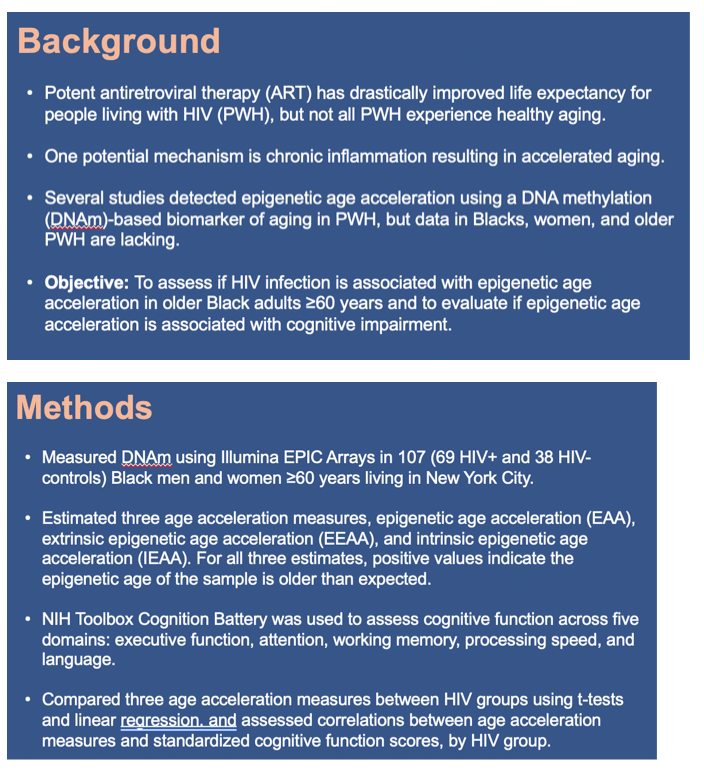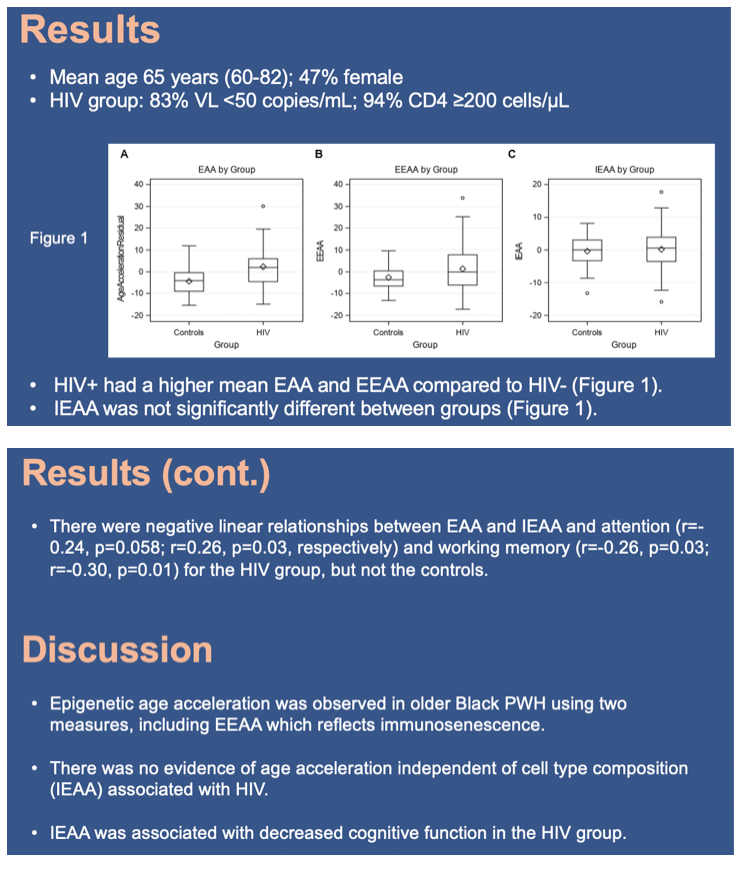 |
 |
 |
| |
EPIGENETIC AGING ASSOCIATED WITH COGNITIVE
IMPAIRMENT IN OLDER BLACK ADULTS WITH HIV
|
| |
| |
What is epigenetic aging: "Inter-individual differences in target organ damage may be a consequence of biological, or physiological, aging due to genetic and/or environmental factors such as inflammation, oxidative stress, or other cellular mechanisms [8]. As described by Karasik et al., biological age is a measure of the functional status of an individual relative to others with the same chronological age group [9]. Biological aging can be estimated using a variety of biomarkers such as functional performance metrics (e.g., measures of frailty), blood biochemistry (e.g., inflammatory markers), telomere length, and, more recently, epigenetics. Measures of biological aging, such as telomere shortening, have been shown to be associated with subclinical measures of function or morphology in the heart [8, 10], kidneys [11], and peripheral vasculature [10]. Epigenetic mechanisms, including DNA methylation, histone acetylation, and microRNA, play a key role in the regulation of gene expression, which is known to change with age [12]. Recently, several methods have been developed that use DNA methylation, cytosine-5 methylation of CpG dinucelotides, to estimate epigenetic age acceleration, the difference between biological and chronological age [13, 14].
Epigenetic age acceleration is significantly associated with a variety of age-related conditions including all-cause mortality [15], cancer incidence and mortality [16], cardiovascular mortality [17], Alzheimer's disease [18], Parkinson's Disease [19], Huntington's Disease [20], and menopause [21]. It is also associated with tissue aging [22] and cellular senescence [13, 23]. In this study, we evaluate two widely utilized measures of age acceleration, intrinsic epigenetic age acceleration (IEAA) and extrinsic epigenetic age acceleration (EEAA). IEAA captures cellular age acceleration independently of blood cell proportions, which are known to change with age. EEAA incorporates intrinsic measures as well as blood cell proportions.."
https://bmcmedgenomics.biomedcentral.com/articles/10.1186/s12920-019-0585-5
"In conclusion, we identified significant associations between the MetS severity score and both IEAA and EEAA cross-sectionally, suggesting with a greater number of MetS components associated with more advanced epigenetic age acceleration. Prospectively, we identified significant associations between epigenetic age acceleration and incident MetS. Epigenetic age acceleration has the potential to be adapted into an early detection biomarker of age-related chronic diseases, which may have a large impact on public health as the population ages. IEAA has been proposed to capture cell-intrinsic properties of the aging process, while EEAA reflects immune system aging. While accelerated epigenetic aging has been associated with lifestyle factors and diseases related to MetS, the relationship between EAA and this metabolic condition is currently not clearly delineated"......https://clinicalepigeneticsjournal.biomedcentral.com/articles/10.1186/s13148-019-0767-1
--------------------------------
CROI 2021 March 6-10 reported by Jules Levin
Stephanie Shiau1, Yanhan Shen2, Anyelina Cantos2, Christian Vivar Ramon2, Jayesh Shah2, Grace Jang2, Jennifer J. Manly2, Adam M. Brickman2, Andrea A. Baccarelli2, Stephen M. Arpadi2, Michael T. Yin2
1Rutgers School of Public Health, Piscataway, NJ, USA, 2Columbia University Medical Center, New York, NY, USA
Background: Several studies detected epigenetic age acceleration using a DNA methylation (DNAm)-based biomarker of aging in people with HIV (PWH), but data in African Americans (AA), women, and older PWH are lacking. We assessed if HIV infection is associated with epigenetic age acceleration in AA older adults, and evaluated if epigenetic age acceleration is associated with cognitive function.
Methods: We measured DNAm in whole blood using Illumina EPIC Arrays in 107 (69 HIV+ and 38 HIV- controls) AA men and women ages 60-75 living in New York City. We estimated three age acceleration measures, where positive values indicate that the blood sample is older than expected based on chronological age: epigenetic age acceleration (EAA), extrinsic epigenetic age acceleration (EEAA), and intrinsic epigenetic age acceleration (IEAA). The NIH Toolbox Cognition Battery was used to assess cognitive function across five domains: executive function, attention, working memory, processing speed, and language. We compared age acceleration measures between groups using t-tests and assessed correlations between age acceleration measures and standardized cognitive function scores, by HIV group.
Results: The HIV+ and HIV- groups did not differ by sex (49 vs 42% female), chronological age (65 vs 66 years), ethnicity (93% not Hispanic or Latino), frailty by Fried criteria (36 vs. 32%), or mean BMI (28.5 vs 30.9 kg/m2). 83% of the HIV+ had a viral load <50 copies/mL and 94% had a recent CD4 ≥200 cells/μL.
Blood cell composition differed between groups, largely driven by higher proportions of CD8 (0.35 vs 0.18, p<0.01) and lower proportions of CD4 T-Cells (0.23 vs. 0.38, p<0.01) in the HIV+ group.
Chronological age correlated with DNAm age (r=0.36, p<0.01). HIV+ had a higher mean EAA (2.4±8.5 vs -4.3±5.6, p<0.01) and EEAA (1.4±10.4 vs -2.5±5.6, p<0.01) compared to HIV-. IEAA was not significantly different between groups (0.2±6.1 vs -0.4±5.0, NS). There were negative linear relationships between EAA and IEAA and attention (r=- 0.24, p=0.058; r=0.26, p=0.03, respectively) and working memory (r=-0.26, p=0.03; r=-0.30, p=0.01) for the HIV group, but not the controls.
Conclusion: Epigenetic age acceleration in blood was observed in AA older PWH using two measures, including EEAA which reflects immunosenescence. There was no evidence of age acceleration independent of cell type composition (IEAA) associated with HIV, but this measure was associated with decreased cognitive function in the HIV group.



|
| |
|
 |
 |
|
|